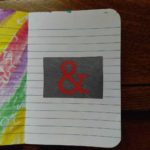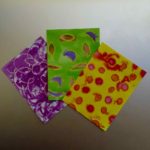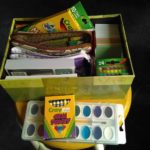I have been drawn to the idea of art journaling for a long time. It was always a combination of overwhelming and frustrating, though, until recently, when I found I had sort of taken it up by accident. It started with the decoupaged notebook craft night – I ended up with a lot of inspirational clippings that didn’t fit onto the covers of my notebooks (physically, or thematically), and decided to glue them into the smallest of my notebooks, making it a sort of “mood board for life.”
I’ve kept adding roughly a page a week to the notebook. Here are some materials and techniques that I’ve used:
- Magazine, catalog, and other clippings – the cover of my tiny notebook is actually out of a credit card offer, and the ampersand in the photo below is out of a newsletter from my health insurance company.

- Printouts from the internet – sometimes I look up a specific image that I want (since I’m unlikely to draw it to my satisfaction!), and sometimes an image crosses my path that’s worth hanging on to.
- Stickers – I especially like letter stickers because I have limited skills with hand-lettering, but any stickers with suitable symbols or messages are welcome.
- Crayon resist watercolor – write a message in light-colored crayon (assuming you’re using white paper), and then paint over it with very wet watercolor. Makes a mess of neighboring pages but a really nice effect; slide waxed paper underneath the page you’re painting to protect the next ones down. If you can go really wet, put drops of paint onto wet paper and the crayon marks will (imperfectly) contain them as they spread. The photo below is that effect, done on index cards.

- Sharpie with colored pencil background – the permanent marker will lay down enough color that you can color in the background afterward with just about any colors and still be able to read it.
- “Crayon resist markers” – this doesn’t really work the same way as with paint, but you can write with crayon and color over it with markers and get a somewhat similar effect.
- Just writing, but with colorful pens – I have a set of gel pens I’m mildly obsessed with (Pilot G-2 Metallics), so sometimes I just write whatever it is I’m recording with them.
- Marked-up writing – however your message is recorded, you can underline, circle, put arrows to, or otherwise highlight the key words with doodling.
 I keep some newspaper and waxed paper with my art supplies to protect neighboring pages and my desk from my various experiments. None of my art supplies are “artist quality”; most are Crayola products aimed at grade schoolers.
I keep some newspaper and waxed paper with my art supplies to protect neighboring pages and my desk from my various experiments. None of my art supplies are “artist quality”; most are Crayola products aimed at grade schoolers.
I think my problem before was two pieces: overly high expectations for what I could/should produce, and expecting to just know what to put into the art journal. You see pictures online of people who art journal extensively and they appear to fill two facing pages of a large sketchbook every day with renditions of the thoughts and events of their lives — that’s not going to be me, and I should recognize that! Two-dimensional art has never been my medium, and I’m not going to suddenly know how to draw or paint by magic; I’ve also never maintained a diary for more than two months at a time, so why would it suddenly be easier to maintain one that requires a lot more effort?
For me, art journaling is more about making things that stand out in my mind also stand out on paper – and I don’t have two pages a day of that kind of content.
In fact, for a long time I had very little of that content. I have found, however, that adding “non-art” journaling to my life – which is still not diary-style, and about which more in future posts – has created the contents to put into the art journal. Funny, that – taking time specifically to think about my life has allowed me to articulate the things I want to remind myself of. Kind of a big duh but it was only clear to me in hindsight!


